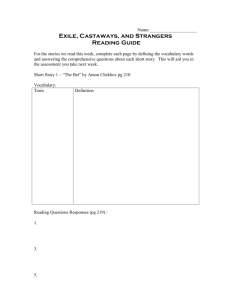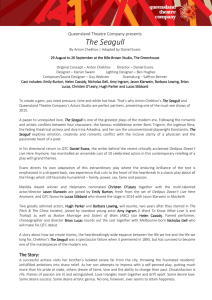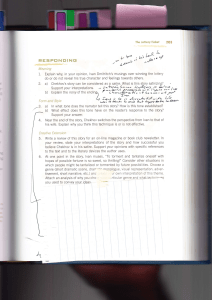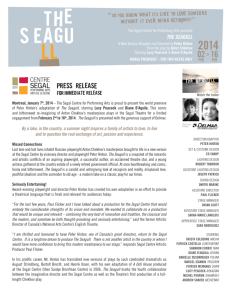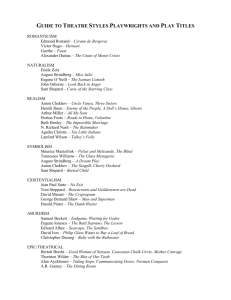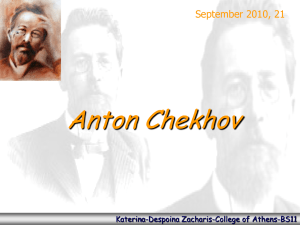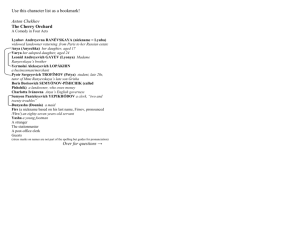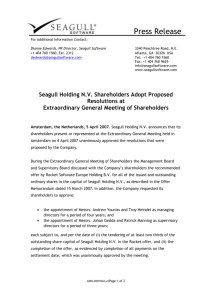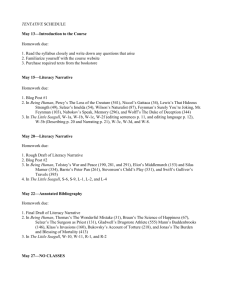Check out our Study Guide!
advertisement
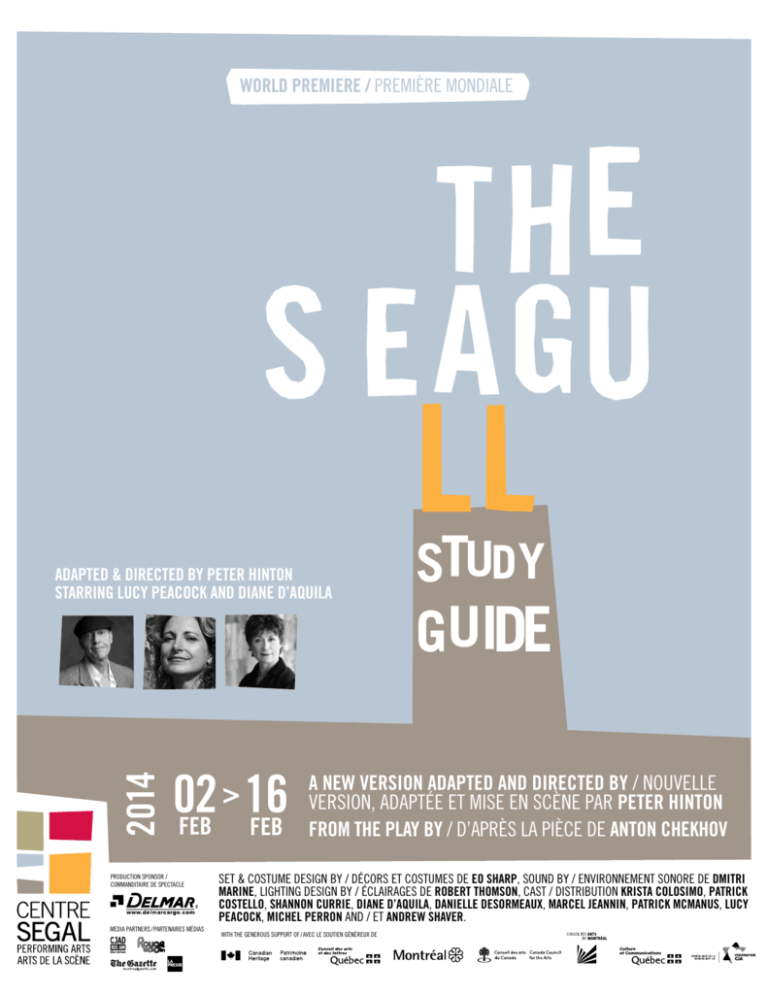
WORLD PREMIERE / PREMIÈRE MONDIALE ADAPTED & DIRECTED BY PETER HINTON STARRING LUCY PEACOCK AND DIANE D’AQUILA 02 16 FEB FEB 17 01 NOV DEC PRODUCTION SPONSOR / COMMANDITAIRE DE SPECTACLE ® MEDIA PARTNERS / PARTENAIRES MÉDIAS STUD Y GUIDE A NEW VERSION ADAPTED AND DIRECTED BY / NOUVELLE VERSION, ADAPTÉESHAKESPEARE ET MISE EN SCÈNE PAR PETER HINTON BY / DE WILLIAM DIRECTED BY / MISE EN SCÈNE ALISON DARCYCHEKHOV FROM THE PLAY BY / D’APRÈS LA DE PIÈCE DE ANTON SET & COSTUME DESIGN BY / DÉCORS ET COSTUMES DE EO SHARP, SOUND BY / ENVIRONNEMENT SONORE DE DMITRI MARINE, LIGHTING DESIGN BY / ÉCLAIRAGES DE ROBERT THOMSON, CAST / DISTRIBUTION KRISTA COLOSIMO, PATRICK COSTELLO, SHANNON CURRIE, DIANE D’AQUILA, DANIELLE DESORMEAUX, MARCEL JEANNIN, PATRICK MCMANUS, LUCY PEACOCK, MICHEL PERRON AND / ET ANDREW SHAVER. WITH THE GENEROUS SUPPORT OF / AVEC LE SOUTIEN GÉNÉREUX DE The Seagull directed and adapted by Peter Hinton | From the play by Anton Chekhov | A Segal Centre production | 2 - 16 February, 2014 www.segalcentre.org 1 CON 3 4 5 6 7 8 9 10 11 12 13 14 15 16 17 18 SYNOPSIS & CHARACTERS ...AND PRODUCTION CREDITS TO LOVE SOMEBODY : UNREQUITED LOVE IN THE SEAGULL THE MEANING OF LIFE ... AND THE DYING FARM HIGH vs. LOW ART ...AND THE SEAGULL INNOCENCE & EXPERIENCE ...AND THE LAKE THE SCRIBBLES ...AND AN INVITATION TO SEE MORE ADAPTATION ...AND WHAT ELSE IS HAPPENING THE THEATRE ...AND YOU WORKSHOPS : HOW TO CREATE STORIES CHEKHOV’S RUSSIA : A SHORT TOUR THE PLAYWRIGHT : A BRIEF BIOGRAPHY THE DIRECTOR : A BRIEF BIOGRAPHY THEATRE ETIQUETTE THANK YOU FOR YOUR FEEDBACK LINKS CONTACT TEN TS ABOUT THIS STUDY GUIDE This study guide is organized by major themes in the play. For each theme, a quote from this original adaptation by Peter Hinton has been chosen as a textual support, and, when applicable, the symbolic device that best represents that theme is included on the appropriate page. Examples of the theme, collected from other disciplines, are briefly summarized in the right-hand column on those pages. In-class or essay questions relating to each theme are noted with a ? throughout this guide. External web links are marked with For users who have opted to use this guide in hard-copy, the web links are listed on page 17. You can see an english translation of the Chekhov original (translator unknown) here on project Gutenberg. This Study Guide was compiled by Lucie Lederhendler, Educational Programs Manager, for the Segal Centre for Performing Arts. It may be used solely for educational purposes. Please contact her for more information on this guide or other Segal Centre educational programming or offerings, such as a private workshop for your students (Page 11). Contact information can be found on Page 18. The Seagull directed and adapted by Peter Hinton | From the play by Anton Chekhov | A Segal Centre production | 2 - 16 February, 2014 www.segalcentre.org 2 The Seagull explores themes of innocence and experience, love, the artist’s struggle with his work and dreams, and questions the meaning of life itself. The story begins with Sorina, a retired judge, who has invited a group of friends and family to visit her lakeside property in the country. Medvedenko and Masha walk through the country estate talking of wealth and happiness while they wait for Constantine’s new play to begin. Constantine stages his new abstract play on an outdoor stage. Nina has sneaked across the lake without her father’s permission in order to perform in it. Arkadina voices her criticisms during the performance, causing Constantine to get angry and shut down the production. He runs off upset, while Nina exchanges pleasantries with Trigorin and Arkadina. She then returns home so she doesn’t get in trouble with her parents. Some days later in Act II, Nina grows closer to Trigorin, causing Constantine to become upset and shoot a seagull. He claims he killed the seagull for Nina and accuses her of being cold to him because of his unsuccessful play. He finds no reassurance, and storms off again. Trigorin, upset that he spent so much of his youth writing and working, is entranced by Nina’s youth and wants to be with her. In Act III, Arkadina and Trigorin consider leaving the country in the wake of a suicide attempt by Constantine. Sorina persuades Arkadina to stay and be with her son. Arkadina and Constantine reminisce fondly, but it turns into another argument. Masha, fundamentally depressed about her unrequited love for Constantine, decides to marry Simon Medvedenko in order to move on. Sorina has an “episode”, where she nearly faints because she has overexerted herself, worrying Arkadina. Nina gives Trigorin a note saying to look at a line in one of his books saying “If you ever need my life, come and take it”. Arkadina forces him to stay with her, leave the failing farm, and forget about his attraction to Nina. The two of them leave, but not before Trigorin can share a passionate kiss with Nina and tell her where they will be staying. Act IV takes place two years later at the farm. Sorina’s health is rapidly declining, and Constantine lives with her. Masha and Medvedenko are married with a baby. Constantine’s writing has begun to take off in the last two years. Nina had a long affair with Trigorin before he returned to Arkadina after his and Nina’s baby died shortly after birth. Nina has been regularly acting but has not found any success. Arkadina and Trigorin arrive at the house. When the power fails at the house the group decides to pull out some board games. Meanwhile, in a side room, Nina sneaks up to the door and talks with Constantine. She is wretchedly depressed, now identifying with the dead seagull instead of the live one. She leaves in a hurry to avoid running into Trigorin, whom she still loves. Constantine, hurt by this news, exits. Dorn pulls Trigorin aside and tells him to get Arkadina out of the house because Constantine has just shot himself. Look on the next page for a map of the love triangles in The Seagull. BASED ON THE PLAY BY ADAPTED AND DIRECTED BY Anton Chekhov Peter Hinton SET AND COSTUME DESIGNER Eo Sharp LIGHTING DESIGNER Robert Thomson SOUND DESIGNER Dmitri Marine SYNOP SIS & CHA RACT ERS CAST ARKADINA Lucy Peacock A celebrated actress, sister of Sorina CONSTANTINE Patrick Costello An aspiring writer, son of Arkadina SORINA Diane D’Aquila A recently retired judge, owner of the country estate NINA Shannon Currie An aspiring actress, neighbour to Sorina SHAMRAEV Michel Perron The estate manager, Polina’s husband POLINA Danielle Desormeaux The wife of Shamraev, mother of Masha MASHA Krista Colosimo The daughter of Polina and Shamraev TRIGORIN Marcel Jeannin A famous writer, Arkadina’s boyfriend DORN Patrick McManus A doctor and old friend MEDVEDENKO Andrew Shaver A school teacher in the nearby town STAGE MANAGER Brian Scott ASSISTANT STAGE MANAGER Sarah-Marie Langlois APPRENTICE STAGE MANAGER Sara Rodriguez The Seagull directed and adapted by Peter Hinton | From the play by Anton Chekhov | A Segal Centre production | 2 - 16 February, 2014 www.segalcentre.org 3 TO LOVE SOME BODY “Do you know what it’s like to without it love someone ever being returned?” Masha, Act I (Hinton 2013) MEDVEDENKO MASHA CONSTANTINE TRIGORIN NINA POLINA DORN SORINA ARKADINA SHAMRAEV And that’s not even all of it. Click here for a presentation, hosted on prezi.com. The || From || A || 2 The Seagull Seagull directed directed and and adapted adapted by by Peter Peter Hinton Hinton From the the play play by by Anton Anton Chekhov Chekhov A Segal Segal Centre Centre production production 2 -- 16 16 February, February, 2014 2014 www.segalcentre.org www.segalcentre.org 4 “Art. To be an artist, an actress - I would suffer anything. My family could disown me... cut me off, never speak to me again. Bring on the rats and the garret - I’ll take the starving artist thing all the way. I know you’ve got to suffer and struggle...but I know that in the end it’ll all be worth it.” Nina, Act II (Hinton 2013) The banality of existence is a fundamental force in most of Chekhov’s work. His stories develop out of the conflict between that inertial force and the human impulse to create a meaningful life of action. Obsessed with this contradiction, his characters engage in work without any real value, desperate to find a way to force the nothingness out of their lives. His characters crave personal connections, but sabotage their chances at it by selecting nonreciprocating targets. The artists, confusing love with inspiration, love selfishly. None of them feel like they are heard, and none of them ever listen, so the art they create can be thought of as their form of communication. Nina says to Trigorin in Act I, “I would think that for someone who has written great books like you - the act of creating would be all that you’d wish for.” Likewise, when Constantine asks Dorn, who is not an artist, if he should continue to write in Act I, Dorn responds, “Just write about what’s meaningful to you.” He goes on, “if I could experience the spiritual feeling that a writer must feel when he’s writing something...I think I could give up...all the physical and material pleasure I have known...” Dorn, perhaps the most reasonable character in the cast, feels that without the commitment to artistic pursuits the question of meaning is inevitably out of his reach, though supporting his friends and advising kindness does seem to give him a sense of identity. The diagnosis of depression is obvious for Masha and Constantine, though only Constantine uses that term, Masha opting for the more poetic “mourning”. For them, depression is a companion. In a way, it opposes their loneliness. The other characters are afraid of those things they cannot control: life, aging, and death. Constantine says that his performance is about “what life could be...might be...as it is in dreams.” Sorina struggles with the meaning of her life after her career. She is vice-ridden, tired, a chain smoker and a heavy drinker. She’s only 65 years old and sees the life that remains for her as a chore. She is happy to shorten her life with unhealthy decadences, saying “What’s the point of retirement if I can’t enjoy it?” She considers it a replacement for too disciplined a youth. To the contrary, in the final scenes of the play, when her health is very poor and she reflects on her regrets in the form of a short story. The audience learns that she wanted to marry, wanted to die in a home in the city, and wanted to write. ...AND THE DYING FARM. Shamraev runs the estate, including the agriculture. He has tried many initiatives, all of which have failed. Unlike a person, a farm has an obvious and practical meaning for existence, which is to produce a yield of product. In this adaptation, Shamraev also has but one goal: to complete his collection of signed playbills. If there is a moral to this play, it may be that to have a goal in life is to suffer, and to achieve that goal is to finish living. ? Which of the philosophies mentioned in the right-side column do you think Chekhov subscribes to? Hinton? the characters? Articulate the life goals of each character. How do characters with a concrete life goal compare to characters with an abstract one? THE MEA NING OF LIFE IN PHILOSOPHY Until the 19th century, the western philosophers who dealt with the question of the meaning of life based their inquiries on the idea that ultimately, all actions should be directed towards improvement, or moving ever closer to an ultimate “goodness.” In other words, the meaning of life is to become enlightened. This concept runs through most humanist philosophies, religious and secular alike. Plato was an early contributor to this conversation in The Republic (Book VII). He describes the experience of life as a projection, like shadow puppets on a wall. Enlightenment is the turning of the head to see the sources of the shadows. Philosophers continued to articulate the nature of enlightenment, including the nature of happiness, virtue, and civic duty, until the 19th century, when Existentialists such as Jean-Paul Sartre argued that there is no ultimate exterior goal. In Existentialism, abstract, valued concepts are invented within the mind and can therefore not be universal. This paved the way for the philosophies of Soren Kierkegaard, Albert Camus, and their contemporaries, which called life “absurd.” This is not the same concept as meaninglessness, as it encourages living beings to be content to live well without meaning. Nihilism, on the other hand, asserts that life is meaningless, and does so without offering a solution. Nihilist thinkers like Friedrich Neitzsche expand on the idea that all value is subjective, adding that what we know of as facts and the very world are just as subject to the perspective of the observer, and that none of them, therefore, really even exist. The Seagull directed and adapted by Peter Hinton | From the play by Anton Chekhov | A Segal Centre production | 2 - 16 February, 2014 www.segalcentre.org 5 “ Really talented? I am smarter than both of you put together if you want to know the truth - you’re in a rut - all of you - you’ve taken the top positions in the art world and you think what you do is legitimate ... and you suppress and silence everybody else. I don’t believe in any of you.” Constantine, Act II (Hinton, 2013) The artists in The Seagull are perhaps the most tortured characters in the play. They yearn for something abstract, unable to articulate exactly what will make them happy, so they place an almost sociopathic emphasis on the art they create. The other characters - a judge, a doctor, a grounds keeper - have relationships with art as well. Dorn sings to keep things light, Sorina’s final regret is that she never became a writer, and Shamraev’s creative urges are expressed in his fandom. It becomes clear that Arkadina’s successful career as an actress can be attributed to the simple talent of being a compelling subject to watch. As such, her self-worth becomes inextricably tied to the quantity of attention she receives. Constantine, having come of age in the shadow of that narcissism, evaluates his self-worth in a far more internal way, yearning to be misunderstood, creating absurd, unrelatable works. Trigorin is universally praised and therefore certain of his skills and posessing of an unshakable confidence. HIGH vs. LOW ART EXAMPLES OF NON-OBJECTIFICATION IN HIGH ART The art establishment of France in the mid 19th-century was centred around a national exhibition in Paris called the “Salon,” where collectors and connoisseurs would view the newest trends in painting. One of the first of Courbet’s paintings to appear in the Salon was A Burial at Ornans (1849-50) (below, click to enlarge.). ...AND THEN THERE’S THE SEAGULL The seagull starts off representing an enviable state of being. It is free, unrestrained, and a supporting and supported part of its environment. Nina so envies these qualities that she identifies with the bird itself. When Constantine kills and gifts the bird to Nina, it represents a fundamental, almost pathological misunderstanding of the relationship she feels towards it. Where she envies freedom, Constantine yearns for the end of his life, so his killing of the seagull is a misguidedly selfish act. Obsessed with the creative act and in awe of Trigorin, the killing of the seagull speaks to the vampirism of creation: in order to create something new, something else must be destroyed. In order to assert the artist’s existence, another person must be objectified. The seagull was autonomous and alive, and has been reduced, literally, to an objet d’art. Even before his conquest of Nina, Trigorin appropriates the traumatic event of the killing of the seagull for one of his own short stories. He subsequently reduces her to a baby-maker, which, when she fails to fulfill that role, leaves her a shell. Nina says, “I am the seagull.” She begins signing her letters “The Seagull.” Her presence as a character in a work of fiction is a symbol of objectification and the cruel tendency to assign misplaced significance to autonomous, innocent individuals. The artistic search for perfection is unattainable, while the plebian drive to create “low art” is entirely within reach, because there is no destruction neccessary for unimportant creation. ? Edouard Manet was another French realist painter who caused a stir in the Paris Salon, with paintings like Le déjeuner sur l’herbe (1862-63) (below, click to enlarge). These paintings were controversial because of the role that the audience was accustomed to taking. In the first, unflattering qualities, such as the ravages of age or alcoholism, were not hidden, giving the viewer no respite from their real life into an idealized fantasy. In Manet’s work, the female nude, who in the past existed solely to be admired, is looking steadfastly back at the viewer, forcing them to acknowledge her personhood. How do artists cover up or highlight the individuality of their subjects? How do the artists in The Seagull do this? Find other examples in art, and compare them to the play The Seagull. The Seagull directed and adapted by Peter Hinton | From the play by Anton Chekhov | A Segal Centre production | 2 - 16 February, 2014 www.segalcentre.org 6 “The bourgeoisie loves so-called ‘positive’ types and novels with happy endings since they lull one into thinking that it is fine to simultaneously acquire capital and maintain one’s innocence, to be a beast and still be happy.” A. Chekhov in a letter to A.S. Suvorin, April 13, 1895. wikiquote The subject of age is present in many of the characters’ interactions throughout The Seagull. Dorn, at the relatively young age of 50, calls himself “too old” so many times during the play that the audience begins to think of him that way. Arkadina desires youth so intensely that she cannot fulfill her role as the mother of a troubled young man. By the end of the play, we have seen Nina, Masha, and Trigorin all become parents, all failed in different ways. Nina, the sole parent who has sacrificed for motherhood, is utterly destroyed by that failure. To become a parent is to move into in older generation. When these characters are aged in this way, the idealized past is undermined as they realize that they wasted their youth being nostalgic, and are condemned to waste their adulthood being obligated to others. Sorina, in her perspective as the senior member of the group, has a unique perspective on regrets. In her poor health in the final act, Polina says, “She’s like a kid again - afraid to sleep in her own room.” Suddenly, youth does not seem so desirable anymore. INN OCEN CE & EX PERI ENCE William Blake’s well known poetry collection Songs of Innocence and Songs of Experience, contains allegories of knowledge and maturity replacing innocence and naiveté, and establishing them as mutually exclusive. Another marker of this obsession with age as it relates to power is the stubborn use of nicknames to refer to characters, such as “Coco” and “Reenie,” particularly in moments of distress, as a way to infantalize them and minimize their emotional response. ...AND THE LAKE The lake in The Seagull seems to contain innocence itself. It is at once haunted with memories of a lost youth and imbued with the hope of its return. When Polina hears the field hands singing across the lake in Act I, Arkadina remembers the role the lake played in her childhood: “When we were kids... we had music and singing on this lake almost every night...” There is a sense that the point of putting on a play at this place is significant for reasons of nostalgia. Later, Dorn, gazing quietly at the lake, says, “I think I could give up all the physical and material pleasures i have known... to just get that high - to let my imagination soar ...” To a crying, lovesick Masha, he says “...everybody’s crying. This lake is haunted - we’re all caught in its spell.” Constantine to Nina, Act II: “Your coldness to me is horrible. I can’t believe it. It’s like waking up one day and seeing that the lake is gone.” The lake, however, is no more in the play than the murder of the seagull. Rather it is off-stage, referenced, gazed at. Instead, these characters are congregated on the shore, close but never touching the chance to revert to an innocent state. In this production, the set design by Eo Sharp adds another layer to this interpretation of the lake. Walls covered in scribble-texture imply the choppy surface of an distressed body of water. As they idealize the setting and place importance on the lake, the non-reflective, agitated surface gives them nothing back. CLICK IMAGE TO ENLARGE From “Earth’s Answer” in Songs of Experience: Earth raised up her head From the darkness dread and drear, Her light fled, Stony, dread, And her locks covered with grey despair. ‘Prisoned on watery shore, Starry jealousy does keep my den Cold and hoar; Weeping o’er, I hear the father of the ancient men. Read the full text at Project Gutenberg. The Seagull directed and adapted by Peter Hinton | From the play by Anton Chekhov | A Segal Centre production | 2 - 16 February, 2014 www.segalcentre.org 7 “Once in a thousand years I speak. No one listens to the beginning of the end. The father of eternal matter The only God mankind did comprehend... “ -Nina, Act I (Hinton, 2013) ...AND CONSTANTINE’S CONDITION “Constantine’s scenography for this production of The Seagull offers the naturalness of a summer home amongst trees caught between three large scribbled walls. These large walls covered with tangled lines suggest both drawing and writing. They have a manuscript-like presence, as if we were peering at an author’s work in progress; words erased and re-written, words that disappear becoming abstract patterns. Their roots and inspiration can be found in the work of painter Cy Twombly. Eo Sharp, set designer. “ The large scrawled walls frame the stage. They delimit the space of the play as a fence would, keeping the characters within this enclosure. They feel caught, and only want to leave. The positioning of the two scribbled sidewalls placed on the actual walls of the theatre suggests offstage theatre flats waiting to be put into position for the performance. Their placement is a reminder, an echo of Constantine’s play within The Seagull, and of this production within these walls. The scribbling is as much Constantine’s search as Chekhov’s scribbling is ours. BLES performance at the top of the play offers his onstage audience, as well as the Segal’s audience, a décor of marked walls - scribbles, or griffonage. They enmesh with the landscape as much as they contrast with it. These markings are ambivalent, suggesting an affinity between nature’s spontaneity and the urges of Constantine’s new art. At the same time, they foreground aspects of vagueness, unfinished or fragmented intentions, failed or rejected work, or halfbaked ideas un-severed from tradition... not unlike the failure of the 1896 premiere of The Seagull. Please join us in the ArtLounge, the downstairs cafe at the Segal Centre, for an exhibition of art inspired by the scribble work of American Artist Cy Twombly, curated by Charles Gagnon. Tours and talks with the artists will be announced in 2014. This ambivalence towards art and its role within The Seagull become visible through the precariousness of scribbling. The failure of art to properly position itself as art, has been recuperated as success at times. The calligraphic nature of his drawings speaks to the link between pictorial and linguistic communication, functioning on a more semiotic, or symbolic, form of expression, in contrast to the literal expression of language. Ambivalent marks and attitudes surrounding Constantine’s project inform this exhibition. The artists offer works that are scribbles, works that are concerned with the occasional inability to properly judge one’s own work as art, and that might yet want to retain this condition. Cy Twombly (1928 - 2011) was active in the abstract expressionist movement, working closely with John Cage, Robert Motherwell, and others. For more information on Abstract Expressionism, have a look at the Study Guide for RED, produced by the Segal Centre in Fall of 2012. Click here. Twombly’s work is highly gestural. Without much emphasis on form or colour, he places great importance on the immediacy of the line. “ “ The THE SCRIB Charles Gagnon, curator. Above: Click to enlarge. A detail from Cold Stream, Cy Twombly, 1966. Left: a photograph of the maquette by Eo Sharp. Behind: A study of scribble texture by Eo Sharp, both 2013. The Seagull directed and adapted by Peter Hinton | From the play by Anton Chekhov | A Segal Centre production | 2 - 16 February, 2014 www.segalcentre.org 8 AD Anton Chekhov wrote The Seagull in Russian in 1896. Since then, it has been produced hundreds of times in different languages. Translating, however, is not an exact science. Even the title, “The Seagull,” is not the obvious translation of the Russian, as Russian does not have articles in the same way that English does. “The Seagull” could also be “A Seagull,” or even simply “Seagull,” but translators consider the content of the story and the connotations of each English article to determine the best choice. This is where adaptation and dramaturgy come in. APTA TION Chekhov, like other classic playwrights such as Shakespeare and Molière, is adapted so often because his plays deal with universal human themes, like love, jealousy, and ambition. These emotions and drives do not belong in any particular time period, but settings and mannerisms can be more dated. So theatre artists like Peter Hinton strive to make a play relatable by taking out anachronisms while leaving in the core of the original script. Black Coffee Theatre in the UK, discussed their 2013 adaptation of The Seagull (1) by Luke Adamson like this: “Anyone who knows Chekhov, whether actor, writer or scholar, has an opinion on how it should be interpreted and performed. In this version BCT are not saying how we think Chekhov should be performed, but how Chekhov could be performed. We ask you to leave your preconceptions at the door and immerse yourself in the world we have created as we attempt to excavate and define the work of a master of Russian theatre.” 1. The Woolly Mammoth Theatre in Washington, DC, included an adaptation by Aaron Posner of The Seagull in their mandate to develop, produce, and promote new plays that explore the edges of style and human experience. It ran from May 27 to June 23, 2013. The inclusion of this play, entitled Stupid F##king Bird (2), is a testament to the range of adaptations that are possible from a single original script. Warning: coarse language. 2. The Seagull was recently performed at the Walter Kerr Theater on Broadway. It was a Royal Court Theatre Production, adapted by Christopher Hampton. The performers, including Peter Sarsgaard and Carey Mulligan, respond in this video (3.) Listen to an interview with Christopher Hampton, by clicking here (4): 4. 3. Anya Reiss adapted The Seagull for the Southwark Playhouse (UK), which ran from 8 November - 1 December, 2012 (5.) In a review from The Guardian,6 journalist Mark Lawson compares the standard translation of the opening lines of the play. In three famous versions by Frayn (1986), Stoppard (1997), and Hampton (2007, and seen above), the lines have been translated as follows: 5. Medevenko: Why do you always wear black? Masha: I’m in mourning for my life. I’m unhappy. Reiss’ version, to the contrary, opened like this: Medevenko: Again? Masha: What? Medevenko: Again? Masha glares. Medevenko: Black. Masha: I’m in mourning. Medevenko: For? Masha: My life. Medevenko: Why? Masha: I’m unhappy. Peter Hinton’s version for the Segal Centre production is somewhere in-between: Medevenko: ...but why do you wear black all the time? Masha: I’m unhappy, Simon. I’m in mourning for my life. The Seagull directed and adapted by Peter Hinton | From the play by Anton Chekhov | A Segal Centre production | 2 - 16 February, 2014 www.segalcentre.org 9 “She calls it ‘ a political art form ’? But to me, the theatre doesn’t change things. Nobody goes to the theatre anymore. When you go to a play, how old is the audience? On the average. Sixty? Sixty-five? You never see young people in the theatre - well, not enough of them - and why? Because it isn’t important or relevant to them...to us. You go in and the lights come up on a living room or whatever...then these actors show up and try to represent life, when they can’t even relate to the world themselves.” -Constantine, Act I (Hinton, 2013) On page 13, you will learn that Anton Chekhov was a physician who wrote for extra money, almost as a side project. This is unusual when you think about how much he truly writes about writing. It may be that his disdain for it is in fact what saturates his work with sarcasm. On the other hand, this philosophizing could speak to a conflict of priorities. It is possible that he practices medicine as a logical choice but cannot help but follow his creative impulse to feed a base need. The above quote is from Peter Hinton’s 2013 adaptation for the Segal Centre. Page two contains a link to an unadapted translation. Find the equivalent passage in that script and compare the philosophies of theatre. ? ? ...AND YOU. Encourage students to think about the idea of engagement with a work of art. Upon attending the theatre, notice the demographics of the audience. Think about how the theatre is different from a concert, a movie, or a comedy show. Do you attend performances often? Which kind? THE THEA TRE CONNECT WITH THE SEGAL CENTRE ONLINE For more behind-the scenes insight, trailers, photos, and more! We love to hear from you. facebook.com/segalcentre youtube.com/user/segalcentre Are there art forms at you relate to more than others? What does it mean to you to “relate” to something? ? Theatres in particular often struggle with an aging audience, focusing much effort on bringing a young audience in, through choices in programming, activities, and partial or even total price reduction. What do you think the reason is that theatre audiences are older, and what would you do to counter that? twitter.com/segalcentre Click here for a pre-addressed printable handout of these questions. Click here to send an email to the Educational Programs Manager at the Segal Centre. If your students would like to address a specific member of the Segal staff or of The Seagull production team, please specify to whom the communication should be forwarded. instagram.com/segalcentre llederhendler@segalcentre.org The Seagull directed and adapted by Peter Hinton | From the play by Anton Chekhov | A Segal Centre production | 2 - 16 February, 2014 www.segalcentre.org 10 These dynamic workshops encourage participants... ... to engage with the ERA and the ARTIST. ... to learn about a FAMOUS THEATRE PIECE and better understand the STYLE AND FORM. ... to gain experience as EMERGING CREATORS and PERFORMERS. ... to share a POWERFUL and PERSONAL group-art experience. ( WORK SHOPS ) Workshops are customizable by age and group size, and can be delivered in three styles: • Performance-Oriented; • Writing-Oriented; • Or a Mix of Writing and Performance Activities. LED BY JESSE STONG, the Segal Centre’s 2013-2014 Teacher-in-Residence! Jesse Stong is trained as a Playwright/Director (National Theatre School of Canada, 2013) as well as a Social Worker (Ryerson University, 2004) with over ten years of experience creating and delivering dynamic Writing and Performance workshops for youth/adults from all walks of life. Currently his play about online bullying and suicide, Shared Account, is touring Quebec and East Coast High Schools with Geordie Theatre. As well as being passionate for his Teacher-in-Residence position at Segal Centre, Jesse is also currently Project Manager at ELAN (English Language Arts Network) for the Quebec Youth Resource Centre. RESERVE TODAY! “HOW TO CREATE stories of Celebrity, Bullying and Eg o” Written in 1895, The Seagull is more relevant now than ever. The play provides commentary on our need for celebrity and social status, but also on the illusory nature of those things. It shows us the lives of four people consumed by their craft and their pursuit of relationships. It is a poignant example of how pure boredom, ego and the pursuit of celebrity status can destroy the minds of good people and push us to destroy the lives of others. This workshop will be an opportunity for emerging creator / performers to examine the themes of this classic play; it will provide young writers with activities that will support them to tap into their own experiences of false-celebrity, ego, and bullying (issues that are rampant in our current Internet-Based age). Participants of the workshop will discuss how ego, reputation, and the pursuit of celebrity play a role in the unraveling of the classic Chekhov characters. They will be given journaling exercises to help them tap into their personal experiences of ego and bullying, and will learn how to create authentic flawed characters who are not simply “bad” but have been twisted by forces greater than themselves. Through the creation of honest examples of egotistical, malicious, and cruel-hearted characters, and by examining the current “fame-hungry” culture we live in, emerging artists gain insight on how to not only understand the depth needed to develop interesting characters, but also how to have empathy for others, even those who bully. Ultimately this workshop is about the bullied spirit in all of us reclaiming power through artistic expression and creative writing. The Segal Centre is committed to making arts education accessible. RESERVE TODAY! Contact Lucie Lederhendler at 514 . 739 . 2301 ext. 8360 or llederhendler@segalcentre.org to reserve or for more information. The Seagull directed and adapted by Peter Hinton | From the play by Anton Chekhov | A Segal Centre production | 2 - 16 February, 2014 www.segalcentre.org 11 Chekhov’s life took place between 1860 and 1904 – a time of extreme technological and political change in Russia. In the last couple years of his life came the Boxer Rebellion and Russia’s occupation in Manchuria, the general strike in Tbilisi and Baku, and the Russo-Japanese War. The beginning of the end of the imperial era and imperator/tsar rule in Russia with the events that took place on Bloody Sunday in January of 1905, one year after Chekhov’s death. Here is a simple timeline of important historical events that took place in Russia during Chekhov’s lifetime: 1855-1881: Rule of imperator/Tsar Alexander II Romanov 1860-1873: First railway boom 1861: Emancipation of serfdom in Russia CHEK HOV’S RUS SIA THE SEAGULL, AND... Click images to enlarge. 1867: Alaska sold to the United States 1872: Russian translation of Marx’s Capital 1873: Beginning of the movement To the People (V narod) 1876: Land and Freedom Party 1877-1878: War with Turkey 1877: Treaty of San Stefano Congress of Berlin Begins 1879: People’s Will Party and Black Partition established THIS IS WHAT ARCHITECTURE LOOKED LIKE 1881: Assassination of Alexander II Romanov 1881-1894: Rule of Tsar Alexander III Romanov 1884: Reactionary regulations for universities 1891: Beginning of the Trans-Siberian railway 1891-1893: Beginning of the Franco-Russian alliance 1894: Alexander III Romanov dies of the illness known as nephritis Tsar Nicholas II Romanov takes over the throne 1896: See right... 1900: Boxer Rebellion; Russia occupies Manchuria THIS IS WHAT RUSSIA LOOKED LIKE 1903: Split into Mensheviks and Bolsheviks (link) 1904: General strike in Tbilisi and Baku 1904-1905: Russo-Japanese War 1917:End of Nicholas II Romanov’s reign and of the Czarist Era. Information taken From Russian Studies department at Bucknell University online. See page 17 for the web address. THIS IS WHAT THE ROMANOVS LOOKED LIKE The Seagull directed and adapted by Peter Hinton | From the play by Anton Chekhov | A Segal Centre production | 2 - 16 February, 2014 www.segalcentre.org 12 Anton Chekhov was born the third of six children in a town near the edge of the Black Sea. His grandfather had bought his own freedom from serfdom, and his father, an abusive religious fanatic, worked as a grocer. Although he was no great student, Anton Chekhov’s aptitude with language and performance was clear from his first years in grammar school. In his late teens, financial difficulties forced his parents to relocate to Moscow, where Chekhov would later attend university. Despite having completed university to become a physician, he supported himself in Moscow writing for comic publications. Significantly, a weekly magazine called Fragments (Oskoli) insisted on pieces that were less than two pages in length and consistently comic, which may have directly led to Chekhov’s contribution to modern fiction writing of sparce and economical word choice. In 1895, Chekhov began contributing to the Petersburg Gazette, which gave him an outlet other than humour writing. It was also around this time that he began to display symptoms of poor health, which he ignored, despite his medical training. The mid 1880s were very prolific for Chekhov, who was writing for the extra income he required in order to cover the debts of his two older brothers. By 1890 he had written several plays, which were variously received, but he was becoming cynical about the art world. He slowed down the rate of his production in favour of more complex stories and developed characters. Increasingly bored, he made the dangerous and long trip to the penal colonies of Siberia, which would inspire much of his most well-known work and cement his reputation as a detached political satirist. THE PLAY WRIG HT IN BRIEF 1860 -Born January 17 1875-Family business fails 1879-Enrolled in Moscow University 1882-Began publishing in comic weeklies 1887-Makes theatrical debut 1889-Brother Nicolai dies of tuberculosis 1890-Tavels to Siberian penal colony 1896-The Seagull premieres at Alexandrine Theatre in St. Petersburg 1897-Suffers hemorrhage of the lungs and begins splitting his time between Moscow and Yalta 1898-The Moscow Art Theatre remounts The Seagull to great applause. 1904-The Cherry Orchard opens January 17 1904-Dies July 2 He had a few women in his life, but there is no evidence that he desired or needed romantic company. When the Seagull premiered on October 17, 1896 in St. Petersburg, the audience, lured by the participation of a famous actress, rioted because of the unusual style of the play. This prompted an early closure of the play, and Chekhov swore off theatre. He suffered from multiple hemorrhages, falling quite ill until he stopped writing and other activities and relocating to Nice, France. While in Nice, Chekhov met one of the founders of the Moscow Art Theatre who was enthralled with the “new drama” of The Seagull. It was remounted in 1898 and was an enormous success. Now splitting his time between Moscow and warmer climates, Chekhov continued to write, spending years perfecting The Cherry Orchard. On July 2, 1904 Chekhov died from multiple heart attacks, at 44 years old. Read a longer bio here. “To think that it is the duty of literature to pluck the pearl from the heap of villains is to deny literature itself. Literature is called artistic when it depicts life as it actually is.... A writer should be as objective as a chemist.” The Seagull directed and adapted by Peter Hinton | From the play by Anton Chekhov | A Segal Centre production | 2 - 16 February, 2014 www.segalcentre.org 13 THE DIRE CTOR Peter Hinton is an award-winning playwright, director, and dramaturge. From 2005-2012, he was artistic director of English Theatre at Canada’s National Arts Centre in Ottawa. For the NAC he directed new plays and musicals by Allen Coe, Gloria Montero, Marie Clements, Peter Anderson, and most recently, the premiere of a new play by Toronto’s Poet Laureate, Dionne Brand. He also directed works by Shakespeare, Congreve, Ibsen, Sam Shepard, Michel Tremblay, and Bertolt Brecht. His time at the NAC was renowned for the first all Canadian season of plays, the reinstatement of a resident National English Acting Company, and in 2007, Mr. Hinton partnered with Britain’s Royal Shakespeare Company to co-produce the world premiere of Margaret Atwood’s stage adaptation of her novel, The Penelopiad. This collaboration marked the first partnership between RSC and a Canadian Theatre Company. Prior to the NAC, Peter was associate artist at the Stratford Festival for seven seasons, directing The Taming of the Shrew, Shakespeare’s Universe, The Odyssey, Fanny Kemble, The Duchess of Malfi, Into the Woods, and all three parts of his own verse trilogy entitled The Swanne. Peter has held the position of Dramaturg in Residence at Playwrights Workshop Montreal, and was Associate Artistic Producer for both the Canadian Stage Company and Theatre Passe Muraille in Toronto. Recently, Peter directed the acclaimed production of Andrew Bovell’s When the Rain Stops Falling for the Shaw festival and Oscar Wilde’s Lady Windermere’s Fan. He has directed A Night in November by Marie Jones, Buried Child by Sam Shepard, and his own adaptation of Henrik Ibsen’s A Doll House for the Segal Centre. Also a respected teacher, Mr. Hinton has taught creation for actors at the Ryerson Theatre School and playwriting and period study at the National Theatre School of Canada. His critical dramaturgical essays have been published in Theatrum, The Canadian Theatre Review, and Between the Lines: A Collection of Interviews and Articles on Dramaturgy in Canada, edited by Judith Rudakoff. OTHER CREDITS WRITER The Swanne: George III (The Death of Cupid) 2002 The Swanne: Princess Charlotte (The Acts of Venus) 2003 The Swanne: Queen Victoria (Her Infinite Variety) 2004 Fanny Kemble 2006 AWARDS Audrey Ashley Award for Outstanding Contribution to Theatre Gascon / Thomas Award for Significant Achievement in Canadian Theatre Officer of the Order of Canada “The people who inhabit a play by Chekhov are driven, haunted, frustrated members of the middle class; doctors, accountants and school teachers, who are often contrasted with actors, writers, and philosophers. Together they share a deep sense of yearning; people torn between an idealized past and the promise of a better future.” The Seagull directed and adapted by Peter Hinton | From the play by Anton Chekhov | A Segal Centre production | 2 - 16 February, 2014 www.segalcentre.org 14 THEA Please take a moment to prepare your students or group for their visit to the Segal Centre. Explain to them what is meant by good theatre etiquette and why a few simple courtesies will enhance the enjoyment of the play for all audience members. TRE ETI QUET TE 1. THE SEAGULL will be performed in the main theatre of the Segal Centre. Performances at the Segal are for both groups and the general public. It is important that everyone be quiet (no talking or rustling of materials) during the performance, so that others do not lose their immersion in the “world of the play”. Please do not unwrap candy, play with zippers, or play with your programme. 2. Do not put your feet on the back of the seat in front of you and please do not climb over seats. 3. If you plan to take notes on the play for the purpose of writing a review, please do not try to write them during the performance. Seeing you do this can be distracting for the actors. Please wait until intermission or after the performance is finished to write your reflections. 4. Use of phones or cameras is strictly prohibited inside the theatre. Absolutely no photos or video may be taken without the express consent of management. Composing or reading text messages is forbidden. 5. Use of cell phones, iPods, tablets, or other self-illuminating electronics is strictly prohibited in the theatre. The light from these devices is visible from the stage and in the audience. It is extremely distracting to the artists on stage and inconsiderate to your fellow audience members. 6. Your seat is only guaranteed until the moment the theatre doors close. Late entry is very disruptive; if a patron is tardy we ask that they please follow the instructions of our front-of-house staff. 7. ENJOY THE SHOW! The Seagull directed and adapted by Peter Hinton | From the play by Anton Chekhov | A Segal Centre production | 2 - 16 February, 2014 www.segalcentre.org 15 Please take a moment to tell us about your experience organizing an educational outing at the Segal Centre. Use the rubric below or contact me at any time with any comments or concerns you might have. Thank you, THANK YOU FOR YOUR FEED BACK 1. How would you rate your experience? Extremely positive 1 2 4 5 Extremely stressful 2. How much do you feel your group benefited from the experience? Very much 1 2 3 4 5 Very Little 3. Would you recommend the experience to other group leaders? Wholeheartedly 1 2 3 4 5 Never 4. Will you consider bringing a group to the theatre again? Wholeheartedly 1 2 3 5 Never 3 4 5. What did you enjoy most about coming to see the play? __________________________________________________________________________________________ __________________________________________________________________________________________ __________________________________________________________________________________________ __________________________________________________________________________________________ 6. What aspect of coming to the theatre did you find problematic? __________________________________________________________________________________________ __________________________________________________________________________________________ __________________________________________________________________________________________ _______________________________________________________________________________________________ We welcome all additional comments. __________________________________________________________________________________________ __________________________________________________________________________________________ __________________________________________________________________________________________ __________________________________________________________________________________________ Reply to: Lucie Lederhendler, Educational Programs Manager Segal Centre for Performing Arts llederhendler@segalcentre.org groups@segalcentre.org Tel: 514.739.2301 ext. 8360 Fax: 514.739.9340 The Seagull directed and adapted by Peter Hinton | From the play by Anton Chekhov | A Segal Centre production | 2 - 16 February, 2014 www.segalcentre.org 16 Page 2: “About this Guide” Full Text of The Seagull, by Anton Chekhov. English translation, translator unknown. http://www.gutenberg.org/files/1754/1754-h/1754-h.htm#link2H_4_0003 Page 4: “To Love Somebody” LINKS Slideshow presentation of the character relationships in The Seagull, but the Segal Centre. http://prezi.com/kykqz1jslqfz/?utm_campaign=share&utm_medium=copy&rc=ex0share Page 6: “High vs. Low Art” Image: Gustave Courbet, “A Burial at Ornans”. http://upload.wikimedia.org/wikipedia/commons/a/a0/Gustave_Courbet_-_A_Burial_at_Ornans_-_Google_Art_Project_2.jpg Image: Edouard Manet, “Déjeuner sur l’herbe.” http://upload.wikimedia.org/wikipedia/commons/f/fc/%C3%89douard_Manet_-_Le_D%C3%A9jeuner_sur_l%27herbe.jpg Page 7: “Innocence & Experience” Image: William Blake, “Earth’s Answer”. http://www.britishmuseum.org/collectionimages/AN01300/AN01300281_001_l.jpg Full text of Songs of Experience, by William Blake, from Project Gutenberg. http://www.gutenberg.org/files/1934/1934-h/1934-h.htm Page 8: “The Scribbles” Image: Cy Twombly, “Cold Stream”. http://www.wikipaintings.org/en/cy-twombly/cold-stream%23supersized-artistPaintings-231488 Page 8: “Adaptation” 1. Streaming video trailer: Black Coffee Theatre (UK) http://www.youtube.com/watch?feature=player_embedded&v=z8ECiwBGcCU 2. Streaming video trailer: Woolly Mammoth Theatre (US) http://www.youtube.com/watch?v=El18m55OcPs 3. Streaming video clip, Walter Kerr Theatre (US) http://www.broadwayworld.com/videoplay.php?colid=33615 4. Streaming Audio clip: Christopher Hampton interviewed on National Public Radio (US) http://www.npr.org/templates/story/story.php?storyId=95338431 5. Streaming video trailer: Southwark Playhouse (UK) http://www.youtube.com/watch?v=M7hP7gU_LkI 6. Online review: The Guardian http://www.theguardian.com/stage/2012/nov/19/the-seagull-chekhov-translation-language Page 10: “The Theatre” Document. Printable letter to the Segal Centre from students. http://www.segalcentre.org/wp-content/uploads/2013/12/student-engagement-letter.pdf Page 12: “Chekhov’s Russia” Timeline. https://www.bucknell.edu/academics/majors-and-minors/russian-studies/resources/russian-history/chronology-ofrussia/chronology-through-1917.htm Webpage: further reading on the Bolshevik / Manshevik split. http://www.historytoday.com/richard-cavendish/bolshevik-menshevik-split Image: The tallest buildings of 1896. http://upload.wikimedia.org/wikipedia/commons/4/4d/Tall_buildings_1896.jpg Image: A map of Europe, including Russia, from 1896. http://www.probertencyclopaedia.com/photolib/maps/Map_of_Europe_1896.htm Image: The emperor and Empress of Russia, 1896. http://upload.wikimedia.org/wikipedia/commons/4/43/Emperor_and_Empress_of_Russia_1896_Uhlenhuth.png Page 13: “The Playwright” Website. http://people.brandeis.edu/~teuber/chekhovbio.html The Seagull directed and adapted by Peter Hinton | From the play by Anton Chekhov | A Segal Centre production | 2 - 16 February, 2014 www.segalcentre.org 17 This study guide was compiled by Lucie Lederhendler for the Segal Centre for Performing Arts, with contributions from Jess Fildes, Peter Hinton, Charles Gagnon and Eo Sharp. It may be used solely for educational purposes. To reserve a workshop or tickets, or for citations, materials, or other information, please contact Lucie Lederhendler Educational Programs Manager Segal Centre for Performing Arts 5170, chemin de la Côte-Sainte-Catherine Montréal QC H3W 1M7 llederhendler@segalcentre.org groups@segalcentre.org Telephone : 514.739.2301 #8360 Fax : 514.739.9340 Box Office : 514.739.7944 www.segalcentre.org The Seagull directed and adapted by Peter Hinton | From the play by Anton Chekhov | A Segal Centre production | 2 - 16 February, 2014 www.segalcentre.org 18
